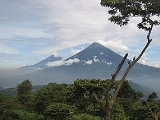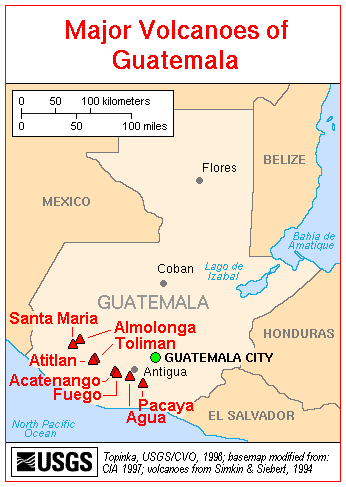
Acatenango
Encyclopedia
Acatenango is a stratovolcano
in Guatemala
, close to the city of Antigua
. The volcano has two peaks, Pico Mayor (Highest Peak) and Yepocapa (3,880 m) which is also known as Tres Hermanas (Three Sisters). Acatenango is joined with Volcán de Fuego
and collectively the volcano complex is known as La Horqueta.
comprises a string of five or more volcanic vents along a north-south trend that is perpendicular to that of the Central American Volcanic Arc in Guatemala. From north to south, known centers of volcanism are Ancient Acatenango, Yepocapa, Pico Mayor de Acatenango, Meseta
, and Fuego
. Volcanism along the trend stretches back more than 200,000 years. Although many of the centers have been active contemporaneously, there is a general sequence of younger volcanism, from north to south along the trend.
This massive volcano complex towers more than 3,500 metres above the Pacific coastal plain to the south and 2,000 metres above the Guatemalan Highlands
to the north. The volcano complex comprises remnants of multiple eruptive centers, which periodically have collapsed to form huge debris avalanches. The largest of these avalanches extended more than 50 kilometres from its source and covered more than 300 square kilometres.
explosions generated ballistic volcanic bomb
s that fell near the summit craters and fine volcanic ash
that fell up to 25 km away.
In prehistoric time, Acatenango has erupted explosively to form widespread fall deposits, hot pyroclastic flow
s and lava
flows. There have been numerous eruptions during the past 80,000 years from vents along the massif. The most recent explosive eruptions of Acatenango occurred 1,900 years ago (Pico Mayor), 2,300 years ago (Pico Mayor) and about 5,000 years ago (Yepocapa). If such eruptions were to recur, many people and costly infrastructure would be at risk.

Stratovolcano
A stratovolcano, also known as a composite volcano, is a tall, conical volcano built up by many layers of hardened lava, tephra, pumice, and volcanic ash. Unlike shield volcanoes, stratovolcanoes are characterized by a steep profile and periodic, explosive eruptions...
in Guatemala
Guatemala
Guatemala is a country in Central America bordered by Mexico to the north and west, the Pacific Ocean to the southwest, Belize to the northeast, the Caribbean to the east, and Honduras and El Salvador to the southeast...
, close to the city of Antigua
Antigua Guatemala
Antigua Guatemala is a city in the central highlands of Guatemala famous for its well-preserved Spanish Mudéjar-influenced Baroque architecture as well as a number of spectacular ruins of colonial churches...
. The volcano has two peaks, Pico Mayor (Highest Peak) and Yepocapa (3,880 m) which is also known as Tres Hermanas (Three Sisters). Acatenango is joined with Volcán de Fuego
Volcán de Fuego
Volcán de Fuego is an active stratovolcano in Guatemala. It is close to the city of Antigua Guatemala. It has erupted frequently since the Spanish conquest. "Fuego" is famous for being almost constantly active at a low level. Smoke issues from its top daily, but larger eruptions are rare. On...
and collectively the volcano complex is known as La Horqueta.
Description
The Fuego-Acatenango massifMassif
In geology, a massif is a section of a planet's crust that is demarcated by faults or flexures. In the movement of the crust, a massif tends to retain its internal structure while being displaced as a whole...
comprises a string of five or more volcanic vents along a north-south trend that is perpendicular to that of the Central American Volcanic Arc in Guatemala. From north to south, known centers of volcanism are Ancient Acatenango, Yepocapa, Pico Mayor de Acatenango, Meseta
Meseta (volcano)
Meseta is a partially collapsed volcanic vent of Volcán de Fuego....
, and Fuego
Volcán de Fuego
Volcán de Fuego is an active stratovolcano in Guatemala. It is close to the city of Antigua Guatemala. It has erupted frequently since the Spanish conquest. "Fuego" is famous for being almost constantly active at a low level. Smoke issues from its top daily, but larger eruptions are rare. On...
. Volcanism along the trend stretches back more than 200,000 years. Although many of the centers have been active contemporaneously, there is a general sequence of younger volcanism, from north to south along the trend.
This massive volcano complex towers more than 3,500 metres above the Pacific coastal plain to the south and 2,000 metres above the Guatemalan Highlands
Guatemalan Highlands
The Guatemalan Highlands is an upland region in southern Guatemala, lying between the Sierra Madre de Chiapas to the south and the Petén lowlands to the north....
to the north. The volcano complex comprises remnants of multiple eruptive centers, which periodically have collapsed to form huge debris avalanches. The largest of these avalanches extended more than 50 kilometres from its source and covered more than 300 square kilometres.
Eruption history
The only known historical eruptions of Acatenango volcano occurred in the 20th century, between 1924 and 1927 from just north of the summit peak (Pico Mayor) and again in December 1972 from the saddle between Yepocapa and Pico Mayor. These phreaticPhreatic
The term phreatic is used in Earth sciences to refer to matters relating to ground water below the water table . The term 'phreatic surface' indicates the location where the pore water pressure is under atmospheric conditions...
explosions generated ballistic volcanic bomb
Volcanic bomb
A volcanic bomb is a mass of molten rock larger than 65 mm in diameter, formed when a volcano ejects viscous fragments of lava during an eruption. They cool into solid fragments before they reach the ground. Because volcanic bombs cool after they leave the volcano, they do not have grains...
s that fell near the summit craters and fine volcanic ash
Volcanic ash
Volcanic ash consists of small tephra, which are bits of pulverized rock and glass created by volcanic eruptions, less than in diameter. There are three mechanisms of volcanic ash formation: gas release under decompression causing magmatic eruptions; thermal contraction from chilling on contact...
that fell up to 25 km away.
In prehistoric time, Acatenango has erupted explosively to form widespread fall deposits, hot pyroclastic flow
Pyroclastic flow
A pyroclastic flow is a fast-moving current of superheated gas and rock , which reaches speeds moving away from a volcano of up to 700 km/h . The flows normally hug the ground and travel downhill, or spread laterally under gravity...
s and lava
Lava
Lava refers both to molten rock expelled by a volcano during an eruption and the resulting rock after solidification and cooling. This molten rock is formed in the interior of some planets, including Earth, and some of their satellites. When first erupted from a volcanic vent, lava is a liquid at...
flows. There have been numerous eruptions during the past 80,000 years from vents along the massif. The most recent explosive eruptions of Acatenango occurred 1,900 years ago (Pico Mayor), 2,300 years ago (Pico Mayor) and about 5,000 years ago (Yepocapa). If such eruptions were to recur, many people and costly infrastructure would be at risk.

Volcanic hazards
The volcano has potential to produce huge debris avalanches that could inundate large areas of the Pacific coastal plain. In areas around the volcanoes and downslope toward the coastal plain, more than 100,000 people are potentially at risk from these and other flowage phenomena.See also
- List of volcanoes in Guatemala
- Mountain peaks of North AmericaMountain peaks of North AmericaThis article comprises three sortable tables of major mountain peaks of greater North America.This article defines greater North America as the portion of the continental landmass of the Americas extending northward from Panama plus the islands surrounding that landmass...
- List of stratovolcanoes

